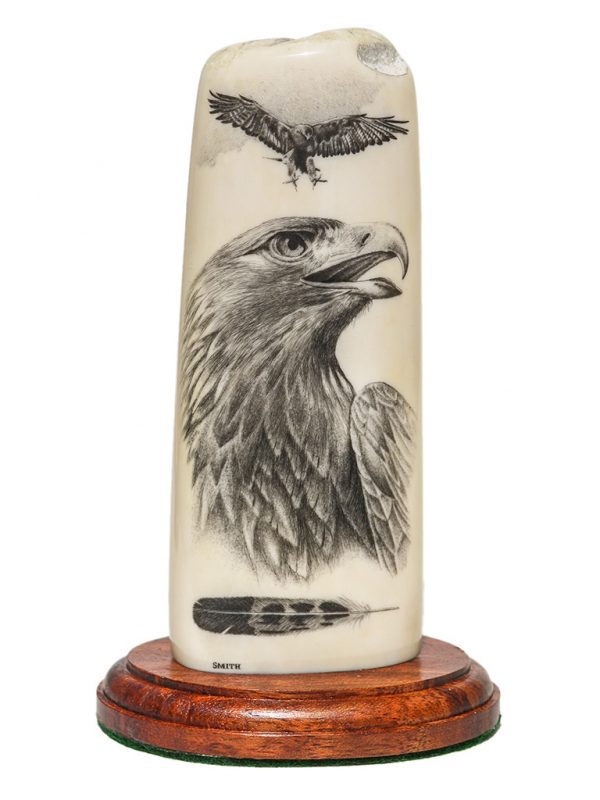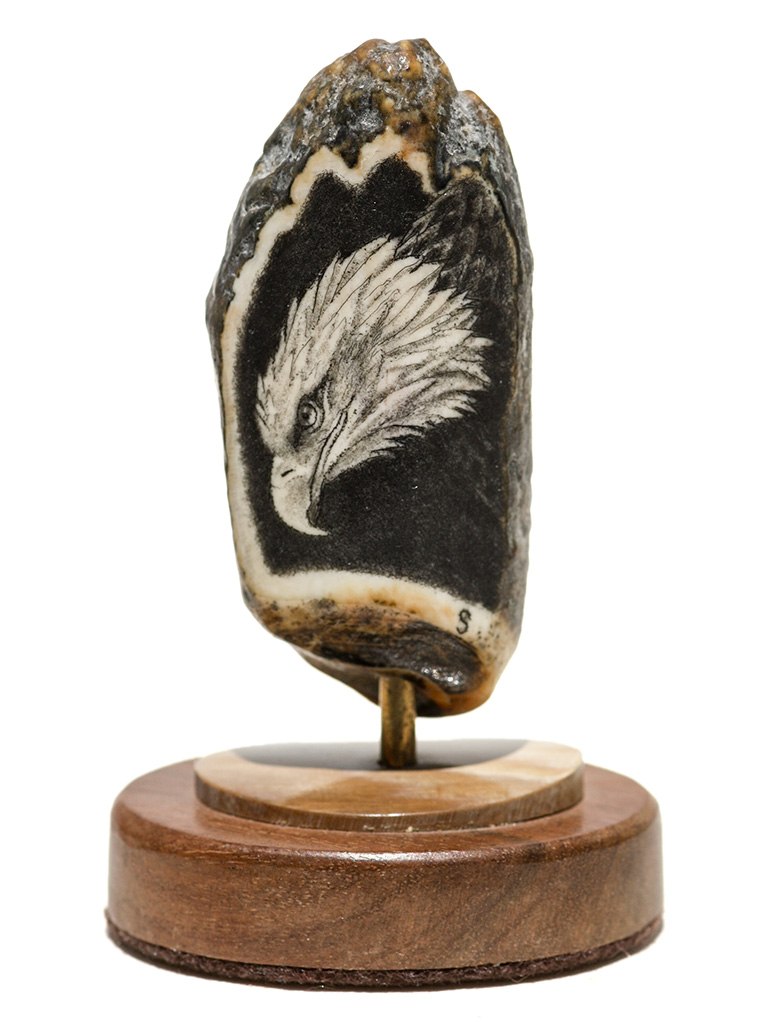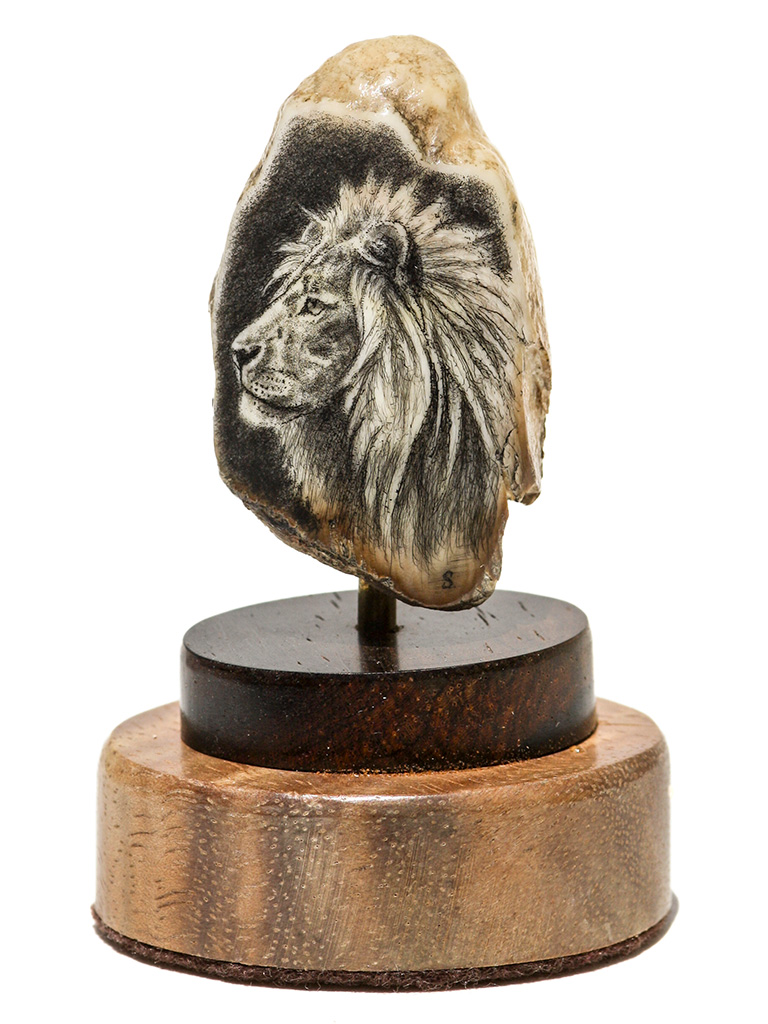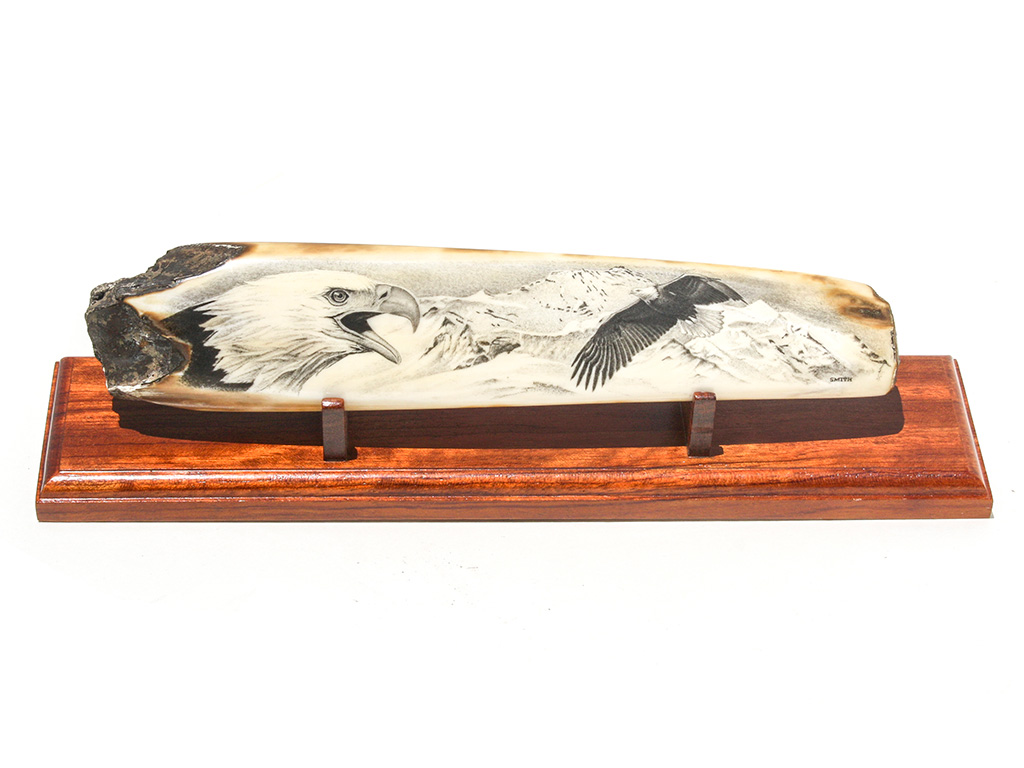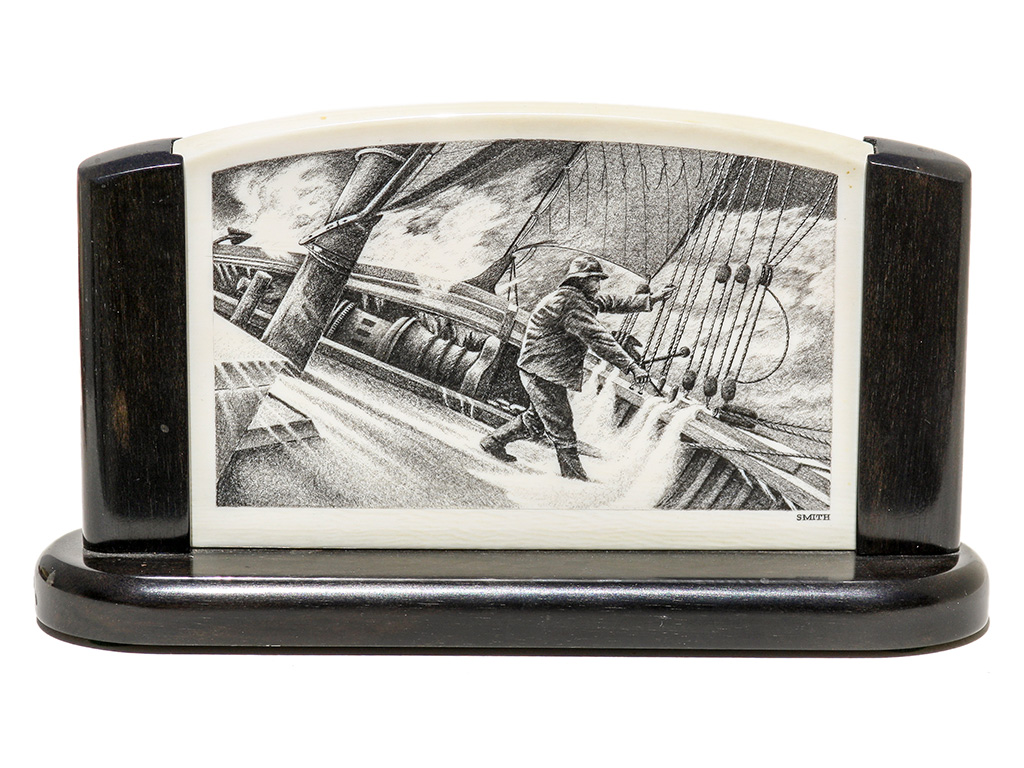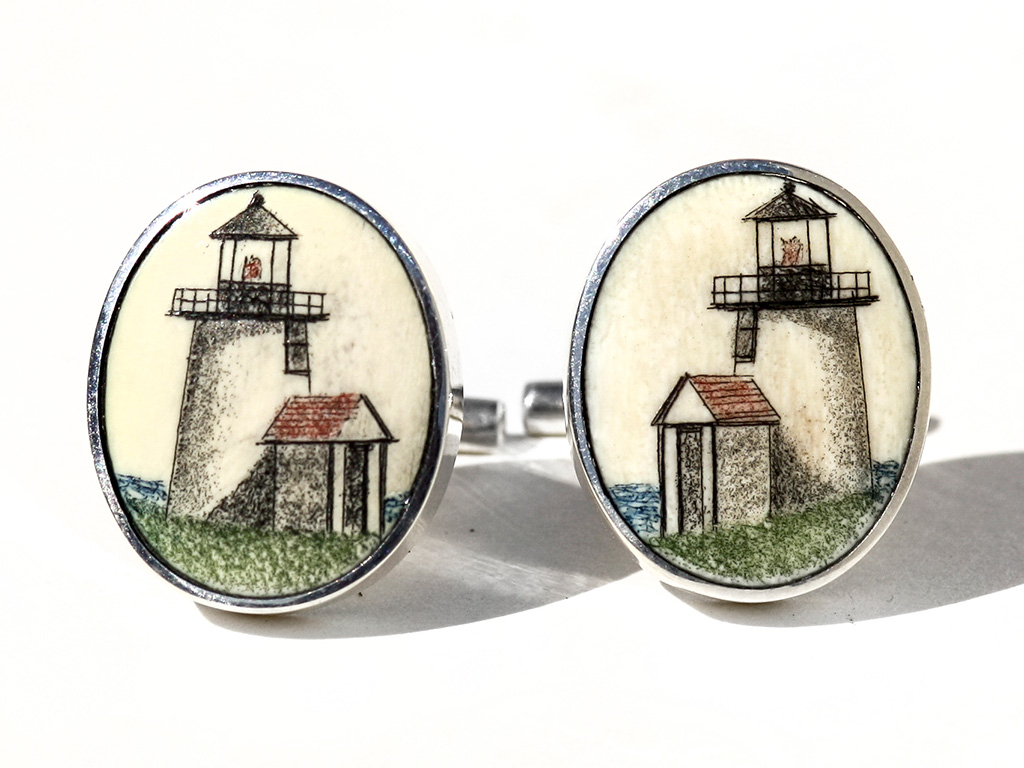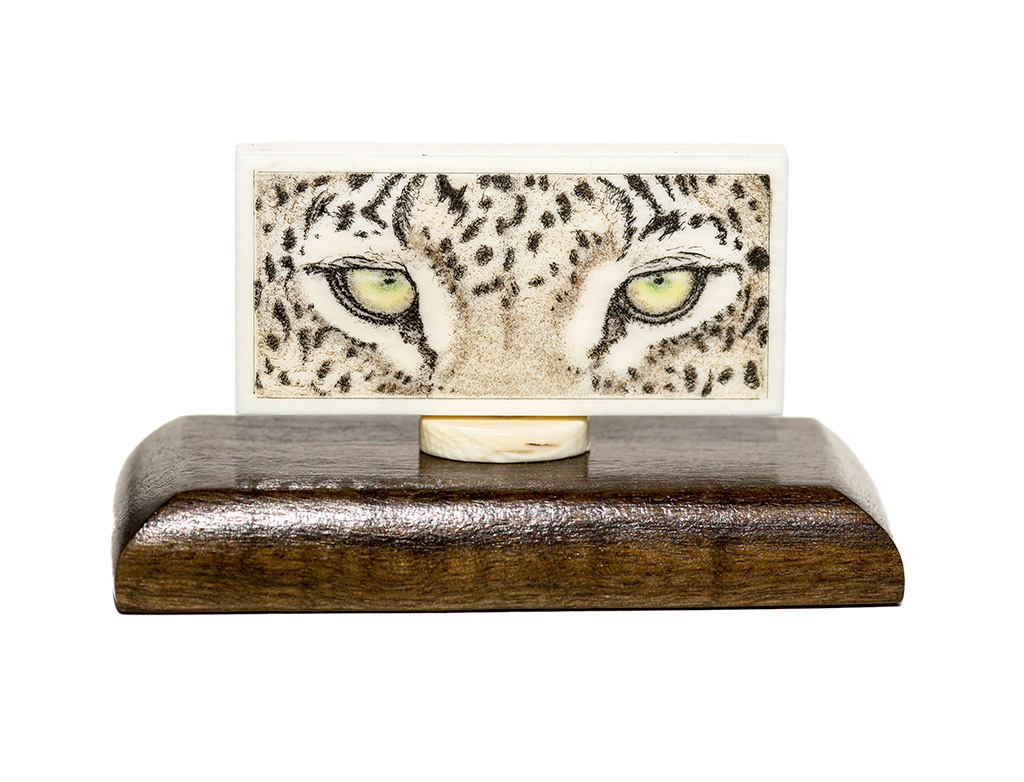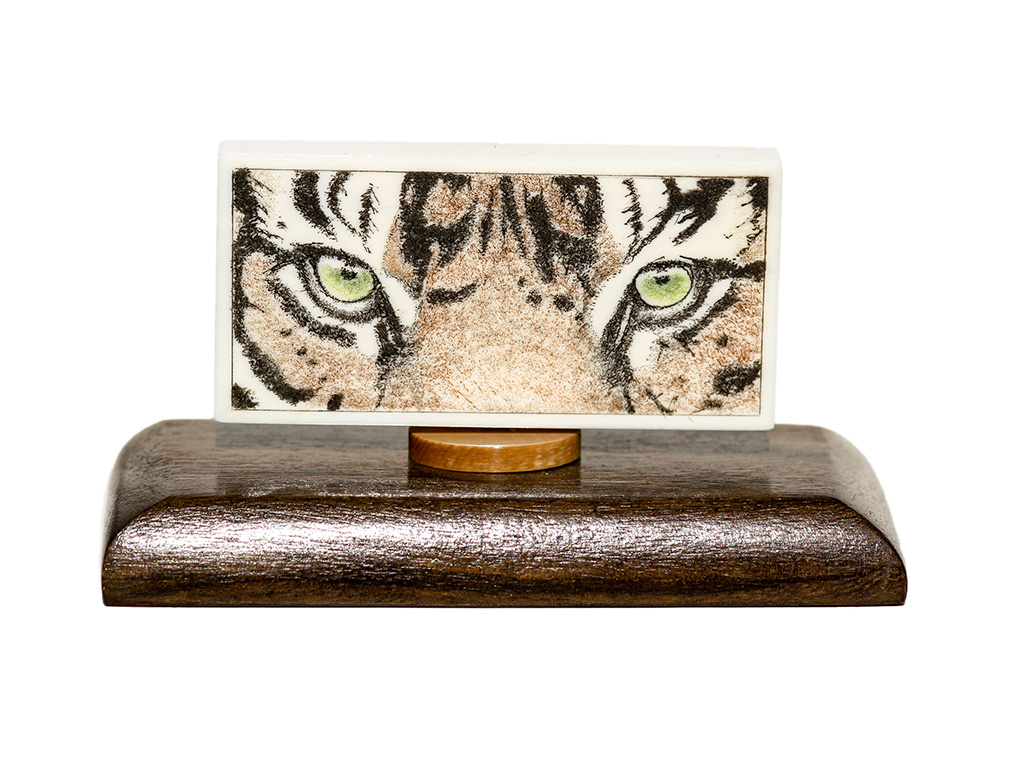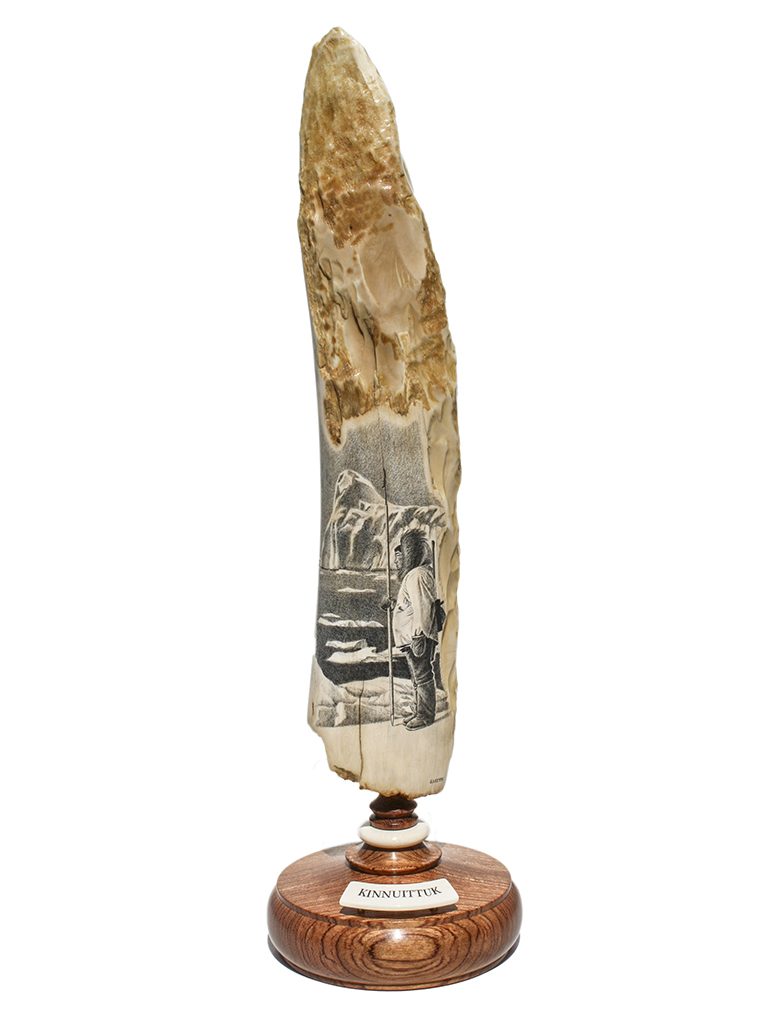“Awesome Golden Eagle” black and white scrimshaw on ancient walrus tusk ivory by David Smith. Stunning portrait of this magnificent eagle. No one does better black and white birds. Love the added detail of the feather at the base. From the collection of one of our clients who is no longer with us. Great piece! Following taken from the internet: The Golden Eagle is one of the largest, fastest, nimblest raptors in North America. Lustrous gold feathers gleam on the back of its head and neck; a powerful beak and talons advertise its hunting prowess. You’re most likely to see this eagle in western North America, soaring on steady wings or diving in pursuit of the jackrabbits and other small mammals that are its main prey. Sometimes seen attacking large mammals, or fighting off coyotes or bears in defense of its prey and young, the Golden Eagle has long inspired both reverence and fear.
“Diving Bald Eagle” black and white scrimshaw on ancient walrus tooth ivory by David Smith. Scrimshander has used the dark tones of the outside of the tooth and created the background to tie everything together. Originally, the other side of the tooth was to be worked, but it was not clean enough for Smith’s brand of scrimshaw. Cocobolo and mammoth ivory stand complete the picture.
“King of the Jungle” black and white scrimshaw on ancient walrus tooth ivory by David Smith. Strong portrait of male lion by master scrimshander, Smith. The stipple work by well known scrimshander is simply amazing. Like the true professional that he is, he always does his very best on each piece of ivory. Nice fat tooth perfect for Mr. Leo.
“Soaring Majestic Eagles” black and white scrimshaw on ancient walrus tusk ivory by David Smith. Excellent composition by veteran scrimshander, Smith. Note the way the color of the ivory blends into the neck of the eagle. Smith’s stipple work is outstanding. No one does it better. Interesting artifact used as some type of digging or scraping tool hundreds of years ago. The back has been polished and it appears that the piece may have been exposed to some type of fire. Attractive stand completes the picture. This is from the collection of one of our clients who is no longer with us.
“Dangerous Heavy Seas” black and white scrimshaw on pre-ban African Ivory by David Smith. Stunning composition by Smith here. One is immediately drawn into the scene. It is difficult to discern the time of day. It could be evening or morning, the storm is so intense all light has been altered. Smith’s signature stipple style of scrimshaw has never been better. The detail of the water crashing over the bulwark shows the strength of the storm. Very large slab of pristine ivory used here set in impressive ebony stand. This was done in 2013 and is from the collection of one of our clients who is no longer with us.
Notice:
This scrimshaw is done on pre-ban African ivory. Since the passage of the CITIES Treaty in 1973, there has been no African ivory brought into the U.S. However, ivory that was in the U.S. prior to 1973 can be legally sold and shipped within the U.S. However, new legislation taking effect in 2016 restricts pre-ban African Ivory from being shipped interstate. It can only legally be shipped intrastate, (within the state). All of our pre-ban ivory is located with our associate in the state of Florida. It can be purchased directly from our website and shipped only to an address within the state of Florida. If one has a relative, trusted friend or business associate within the state of Florida, we can ship to that specified address in order to comply with the new Federal legislation. The scrimshaw can then be forwarded it to you and everyone complies with the law. Any questions email or call us.
“Brant Point Light Cufflinks” color scrimshaw on ancient mammoth tusk ivory by David Smith. Incredible detail by master scrimshander, Smith. Set in sterling silver, these will be worn with pride by both men and women for years and years.
Established in 1746, the Brant Point Light was the second lighthouse established in colonial America. It has since been moved and rebuilt more times than any other lighthouse in the Nation. The present lighthouse is the ninth one built on Brant Point.
“Nelson and Victory” black and white scrimshaw on handmade antique pre-ban African Ivory brushes by David Smith. Extremely rare ivory brushes, made in England, probably between 1850 to 1880 in original leather case. These were for the gentry of the era and the boar bristles are in excellent condition. Many scrimshanders prefer not to work such extreme convex material because it is almost impossible to get the proportions correct. Smith has completely nailed this one. The case itself shows very little wear. Would love to know the complete story of these. Don’t think another pair of these will show up soon.
Notice:
This scrimshaw is done on pre-ban African ivory. Since the passage of the CITIES Treaty in 1973, there has been no African ivory brought into the U.S. However, ivory that was in the U.S. prior to 1973 can be legally sold and shipped within the U.S. However, new legislation taking effect in 2016 restricts pre-ban African Ivory from being shipped interstate. It can only legally be shipped intrastate, (within the state). All of our pre-ban ivory is located with our associate in the state of Florida. It can be purchased directly from our website and shipped only to an address within the state of Florida. If one has a relative, trusted friend or business associate within the state of Florida, we can ship to that specified address in order to comply with the new Federal legislation. The scrimshaw can then be forwarded it to you and everyone complies with the law. Any questions email or call us.
“Leopard Eyes” color scrimshaw on antique ivory domino by David Smith. This is a rare ivory domino that we have had for years. Smith has done a magnificent job, filling up the entire surface. Perfect for the collector who wants something completely different.
Notice:
This scrimshaw is done on pre-ban African ivory. Since the passage of the CITIES Treaty in 1973, there has been no African ivory brought into the U.S. However, ivory that was in the U.S. prior to 1973 can be legally sold and shipped within the U.S. However, new legislation taking effect in 2016 restricts pre-ban African Ivory from being shipped interstate. It can only legally be shipped intrastate, (within the state). All of our pre-ban ivory is located with our associate in the state of Florida. It can be purchased directly from our website and shipped only to an address within the state of Florida. If one has a relative, trusted friend or business associate within the state of Florida, we can ship to that specified address in order to comply with the new Federal legislation. The scrimshaw can then be forwarded it to you and everyone complies with the law. Any questions email or call us.
“Tiger Eyes” color scrimshaw on antique ivory domino by David Smith. This is a rare ivory domino that we have had for years. Smith has done a magnificent job, filling up the entire surface. Perfect for the collector who wants something completely different.
Notice:
This scrimshaw is done on pre-ban African ivory. Since the passage of the CITIES Treaty in 1973, there has been no African ivory brought into the U.S. However, ivory that was in the U.S. prior to 1973 can be legally sold and shipped within the U.S. However, new legislation taking effect in 2016 restricts pre-ban African Ivory from being shipped interstate. It can only legally be shipped intrastate, (within the state). All of our pre-ban ivory is located with our associate in the state of Florida. It can be purchased directly from our website and shipped only to an address within the state of Florida. If one has a relative, trusted friend or business associate within the state of Florida, we can ship to that specified address in order to comply with the new Federal legislation. The scrimshaw can then be forwarded it to you and everyone complies with the law. Any questions email or call us.
“He Is Patient” black and white scrimshaw on ancient walrus tusk ivory artifact by David Smith. The title plate on the stand is engraved “KINNUITTUK” which translates to the phrase “He is patient”. Naturally, one would be patient if one’s existence depended upon bringing back a walrus for food, clothing, tools, etc. Scrimshander Smith has captured the stark environment of the hunter’s world as he stands motionless for hours upon hours waiting for just the right moment. By putting his quarry on the opposite side of the tusk, one wonders if he will be successful on this day’s hunt. This is a very large artifact that was in the process of being worked into an ice axe when it was discarded hundreds and hundreds of years ago. The rough surface of the tusk give the impression of jagged ice floes. Smith has outdone himself with this masterpiece. If you want to acquire a signature Smith scrimshaw work, this is the one.

